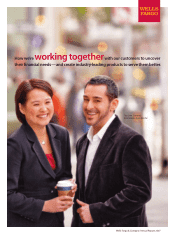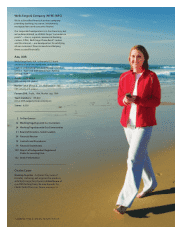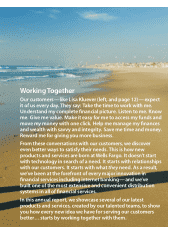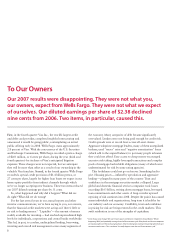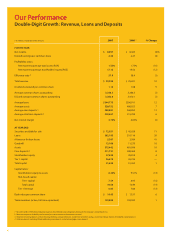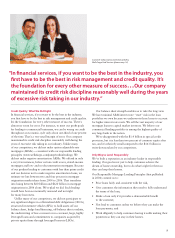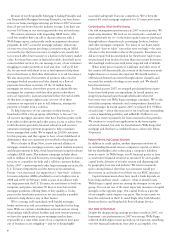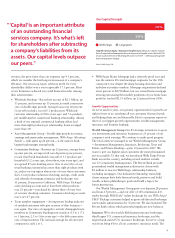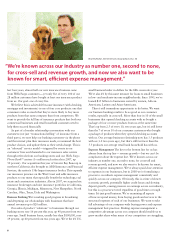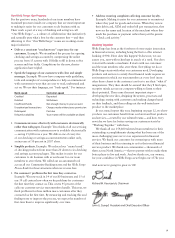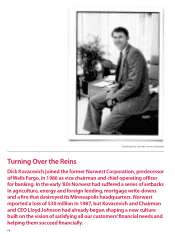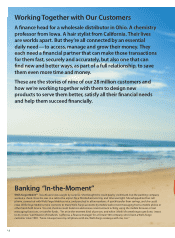Wells Fargo 2007 Annual Report Download - page 10
Download and view the complete annual report
Please find page 10 of the 2007 Wells Fargo annual report below. You can navigate through the pages in the report by either clicking on the pages listed below, or by using the keyword search tool below to find specific information within the annual report.
8
last four years, almost half our new insurance business came
from Wells Fargo customers — yet only five of every 100 of our
28 million customers have bought at least one insurance product
from us. Our goal: one of every five.
We believe this is achievable because insurance (with checking,
mortgage and investments) is one of four core products: one that
consumers value so much that they’re more likely to buy more
products from that same company than from competitors. We
want to provide the full line of insurance products that both our
commercial businesses and retail household customers need to
help them succeed financially.
As part of a broader relationship conversation with our
customers (not just “transactional selling” of insurance from a
third party), we now help our banking customers via the phone
and the internet plan their insurance needs, recommend the best
product choices, and update them as their needs change. This is
an “inbound” service model — triggered by events in our
customers’ lives and channeled to our insurance sales centers
through referrals from our banking stores and our Wells Fargo
Phone BankSM centers (1+ million such referrals in 2007, up
50 percent). Our acquisition this year of Greater Bay Bancorp in
northern California also brought us ABD Insurance and Financial
Services, the nation’s 15th-largest insurance broker. This expands
our insurance presence on the West Coast and adds insurance
products to our menu that especially benefit the technology, real
estate and construction industries. Also in 2007, we acquired six
insurance brokerages and nine insurance portfolios in California,
Georgia, Illinois, Michigan, Minnesota, New Hampshire, North
Carolina, Ohio, Texas, Utah and Washington.
Business Banking We’re making good progress in broadening
and deepening our relationships with businesses that have
annual revenues up to $20 million.
Our sales of product “solutions” to businesses through our
banking stores rose 16 percent this year, up 40 percent from two
years ago. Small business loans, usually less than $100,000, rose
19 percent, up 40 percent from two years ago. We’re the #1 U.S.
small business lender in dollars for the fifth consecutive year.
We’re also #1 by this same measure for loans to small businesses
in low- and moderate-income neighborhoods. Since 1995, we’ve
loaned $35 billion to businesses owned by women, African-
Americans, Latinos and Asian-Americans.
There’s still tremendous opportunity to do better. We want
our business banking results to be as good as our consumer
results, especially in cross-sell. More than four in 10 of the small
businesses that opened checking accounts with us bought a
package of four or more products from us at the same time.
That’s up from 2.5 of every 10, two years ago, but it’s still lower
than the 7 of every 10 of our consumer customers who bought
a package of products when they opened checking accounts
with us. Our average business relationship now has 3.5 products
with us (3.0 two years ago), but that’s still far fewer than the
5.5 products our average retail bank household has with us.
Expense Management The key to the bottom line for us has
always been the top line — revenue growth — but we can’t be
complacent about the expense line. We’re known across our
industry as number one, second to none, for cross-sell and
revenue growth, and now we also want to be known for smart,
efficient expense management. We’ve always paid close attention
to expenses in our businesses, but in 2008 we’re formalizing a
process to coordinate expense management consistently and
quickly across our company. Obviously, this is a time of slower
economic growth, potentially higher credit losses and slowing
deposit growth, causing pressure on earnings across our industry,
but this is a process we need regardless of good times or tough
times. It’s just good business. We’re examining all aspects
of how we spend money, from buying goods and services to the
structural expenses of each of our businesses. We want to take
full advantage of our company-wide buying power and expense
management best-practices. Making expense management a
competitive advantage across our company should enable us to
grow market share when many of our competitors are struggling.
Brian McMahon, Internet Services Group (please see p. 18)
“We’re known across our industry as number one, second to none,
for cross-sell and revenue growth, and now we also want to be
known for smart, efficient expense management.”

